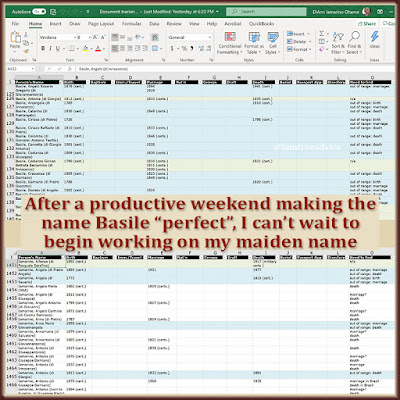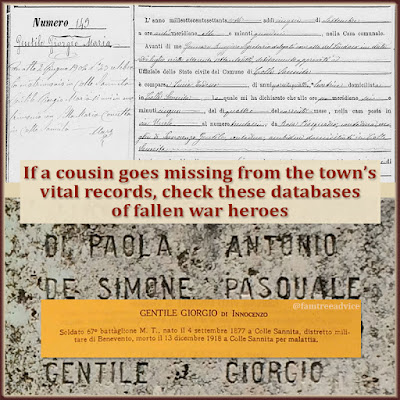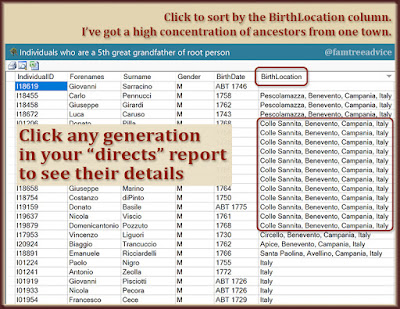I have a mantra for keeping things tidy, and it works for genealogy, too. I call it "all-the-way away," as in "Don't place your shoes by the door. Put them all-the-way away in the closet."
I spent the weekend working on my family tree with this mantra firmly in mind. It's clear that this slower, much more thorough process results in:
- more discoveries
- fixing past errors
- a more fortified family tree
My family tree includes nearly everyone in my small ancestral hometowns. It has 25,306 people. Far too many times I've added names and dates to my tree without being thorough.
When you find a new person to add to your tree, it isn't enough to take down names and dates. You've got to be thorough and add documents and sources right then and there. Put those shoes all-the-way away.
Here's what I'm doing now. I hope it'll inspire you to do something like it.
I've been writing about this book I have, detailing each family in Grandpa's hometown in the year 1742. I want to get every last fact from the book into my family tree. But that means I have to trace all the families back to their ancestors who were alive in 1742. And that means I have to extract every last clue available in the vital records from the town.
I began this journey of thoroughness last week. I chose a last name from the town that's early in the alphabet: Basile. I worked through each Basile in my document tracker spreadsheet. I found and attached missing vital records to each Basile.
I realized I could do a lot more than complete the Basile lines in my document tracker. I could, and should, look at every Basile document in the collection and see if it fits into my family tree. That would be the best possible use of my completely indexed collection of vital records.
 |
| No more rushing through the cousins. I found out this cousin used to live near me. |
But wouldn't it be more fun, rewarding, and engaging to start with my maiden name? Why put off the most important name of all, waiting for it to come up in the alphabet?
Instead of going further with the B names, I jumped to the first Iamarino name in my family tree. Abbonnanzia Iamarino was born in 1848. For each Iamarino name in the index of my family tree:
- I searched my document collection for missing facts
- I cropped each vital record image and attached it to the right person
- I created a thorough source citation for each fact taken from each document image
- I added mention of each new document to my document tracker
I left off on Sunday with Francesco Saverio Iamarino, born on 27 June 1786. It looks as if I have all available vital records for him. I'll mark in my document tracker that his 1st marriage documents are outside the range of available vital records. (His 1st marriage happened before 1802 when he was only 16!)
I can see in my family tree that Francesco Saverio's ancestors are listed in the book of 1742 residents of the town. (I can see this because I use a photo of the book as their profile image.) But one of his grandmothers is a dead end. She was alive in 1742. Is there anything more I can learn about her? I want to be thorough before I move on.
Her name was Angela Caporaso. That wasn't a common last name in this town, so I checked the book's index. I gasped when I saw there was only one Caporaso household in town in 1742.
I turned to entry #9 in the book, and guess what? I found her! This one entry contains a ton of information about Angela's family in 1742:
- her father Francesco had died by 1742
- her mother Elisabetta Scrocca, is 42 years old
- her 17-year-old brother Antonio is now the head of household
- Angela is 14 years old
- her brother Giuseppe is 9 years old
- her older sister Teresa is 22 years old and married to a man from several towns away
None of Angela's family members were in my family tree yet. I would not have found them without thoroughly going through my people one by one. A search of my vital records collection shows no one else named Caporaso in this town. I believe Francesco Caporaso moved here when he married Elisabetta Scrocca. Her name has deep roots in the town. They raised their family here, and it was the first Caporaso family in town. Maybe Angela's brothers Antonio and Giuseppe did not carry on the family name.
Angela Caporaso is no longer a dead-end because I'm squeezing every drop out of the resources that I have. And now I have 25,312 people in my family tree.
 |
| One of my goals is to stretch my families far back enough to find them in the 1742 town register. |
This thorough method is much better than the smash-and-grab genealogy we sometimes do. On Sunday I followed a Donato Iamarino across the ocean to Pittsburgh, Pennsylvania. I found his ship manifest, naturalization papers, and World War II draft registration card. I found his wife's 1958 Pennsylvania death record. I learned that he later moved to Connecticut, where he died in 1981. I was living a few towns away in Connecticut the day he died!
My message to you is to slow down, and enjoy thoroughly exploring each person in your family tree. You don't know where each one will lead you. Each journey may be the most exciting one of all.

















